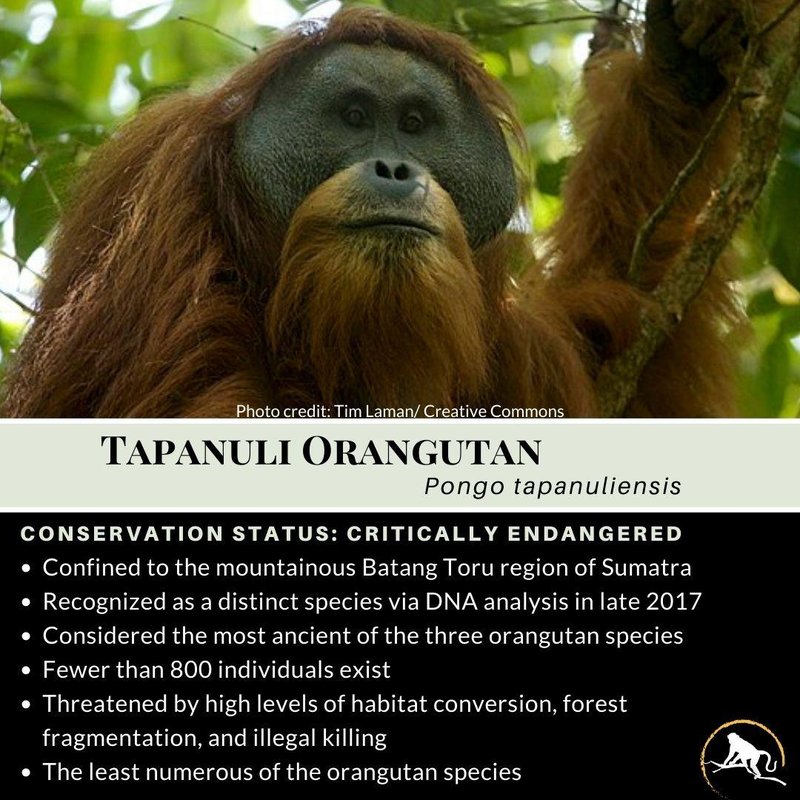
In this article, we’ll explore the habitat and distribution of the Tapanuli orangutan. Think of it as a little journey into the lush forests of Indonesia, where these fascinating creatures make their home. We’ll cover everything from where exactly they live to what their environment looks like. So, grab a cup of coffee and let’s dive in!
Understanding The Tapanuli Orangutan
Tapanuli orangutans are not just any orangutans; they are a distinct species, scientifically recognized only recently. Found in the northern part of Sumatra, these primates are the only great apes native to Asia. They were discovered in 2017, making them one of the latest additions to the orangutan family.
You might be wondering what sets them apart from their cousins, the Sumatran and Bornean orangutans. Tapanuli orangutans are generally smaller and have some unique genetic traits. Their habitat is also more confined, making them particularly vulnerable. It’s like being in a cozy, yet fragile, corner of the world where every tree counts!
Where Do Tapanuli Orangutans Live?
Tapanuli orangutans reside specifically in the Batang Toru Ecosystem, located in northern Sumatra. This area spans around 1,500 square kilometers and includes dense forests and hilly terrains. The forest is rich in biodiversity, with towering trees that make perfect homes for these arboreal creatures.
These orangutans are mostly found at higher elevations, where they can swing from branch to branch, foraging for their favorite foods. Their diet primarily consists of fruits, leaves, and flowers. It’s like having a salad bar up in the trees! But their limited range means that any change to their habitat can have a dramatic impact.
The Importance of Their Habitat
The habitat of the Tapanuli orangutan is essential for their survival. These forests provide everything they need—food, shelter, and a safe place to raise their young. Unfortunately, the distribution of these forests is under threat from logging, agriculture, and other human activities.
You might think about how you’d feel if your home was being taken away. That’s what’s happening to these orangutans. As the forests shrink, their chances of survival diminish. Conservation efforts are critical here, and protecting their habitat is a priority for many organizations working to save these amazing creatures.
Threats to Tapanuli Orangutan Habitat
Sadly, several threats loom over the Tapanuli orangutan’s habitat. One major concern is deforestation. Logging for palm oil plantations, timber, and agriculture has led to substantial habitat loss. Imagine being told you can no longer visit your favorite park—that’s what these orangutans are facing!
Additionally, mining activities and infrastructure development place even more pressure on their environment. The fragmentation of their habitat makes it harder for them to find food and mates.
The situation is serious. It’s like a delicate house of cards that could collapse if proper measures aren’t taken. Conservationists are working hard to raise awareness and implement strategies to protect these orangutans and their forests.
Conservation Efforts for Tapanuli Orangutans
Fortunately, there’s hope for the Tapanuli orangutans! Several organizations are actively focused on the conservation of their habitat. These efforts involve restoring damaged forests, creating wildlife corridors, and advocating for sustainable practices among local communities.
Public awareness is also crucial. Imagine rallying a community to protect a local treasure—this is what conservationists aim for with the Tapanuli orangutans. Engaging local people not only helps protect the orangutans but also promotes sustainable livelihoods, showing that humans and wildlife can coexist.
Every small action counts. Whether it’s supporting eco-tourism or participating in conservation programs, you can help make a difference from anywhere in the world.
The Future for Tapanuli Orangutans
The future of Tapanuli orangutans heavily relies on conservation efforts and public awareness. With only about 800 individuals remaining, they are critically endangered. There’s still a chance to turn things around if we act now.
Encouragingly, ongoing research is helping us learn more about their behaviors and needs. This knowledge aids in creating effective conservation strategies. It’s like piecing together a puzzle—each piece is vital to understanding how to help these incredible creatures.
The fight for their survival is a shared responsibility. When we care about the planet and its wildlife, we pave the way for a brighter future for everyone, including the Tapanuli orangutan.
Summary
In summary, the Tapanuli orangutan is a fascinating species that lives in a specific, fragile part of the world. Their habitat in the Batang Toru Ecosystem is crucial for their well-being, providing food and shelter. However, this habitat faces numerous threats that require immediate action.
By understanding where Tapanuli orangutans live and the challenges they face, we become more equipped to help them. Remember, every little effort counts when it comes to protecting our planet’s unique wildlife. So, let’s keep the conversation going and do our part to ensure that future generations can enjoy the wonder of Tapanuli orangutans in their natural habitat!

